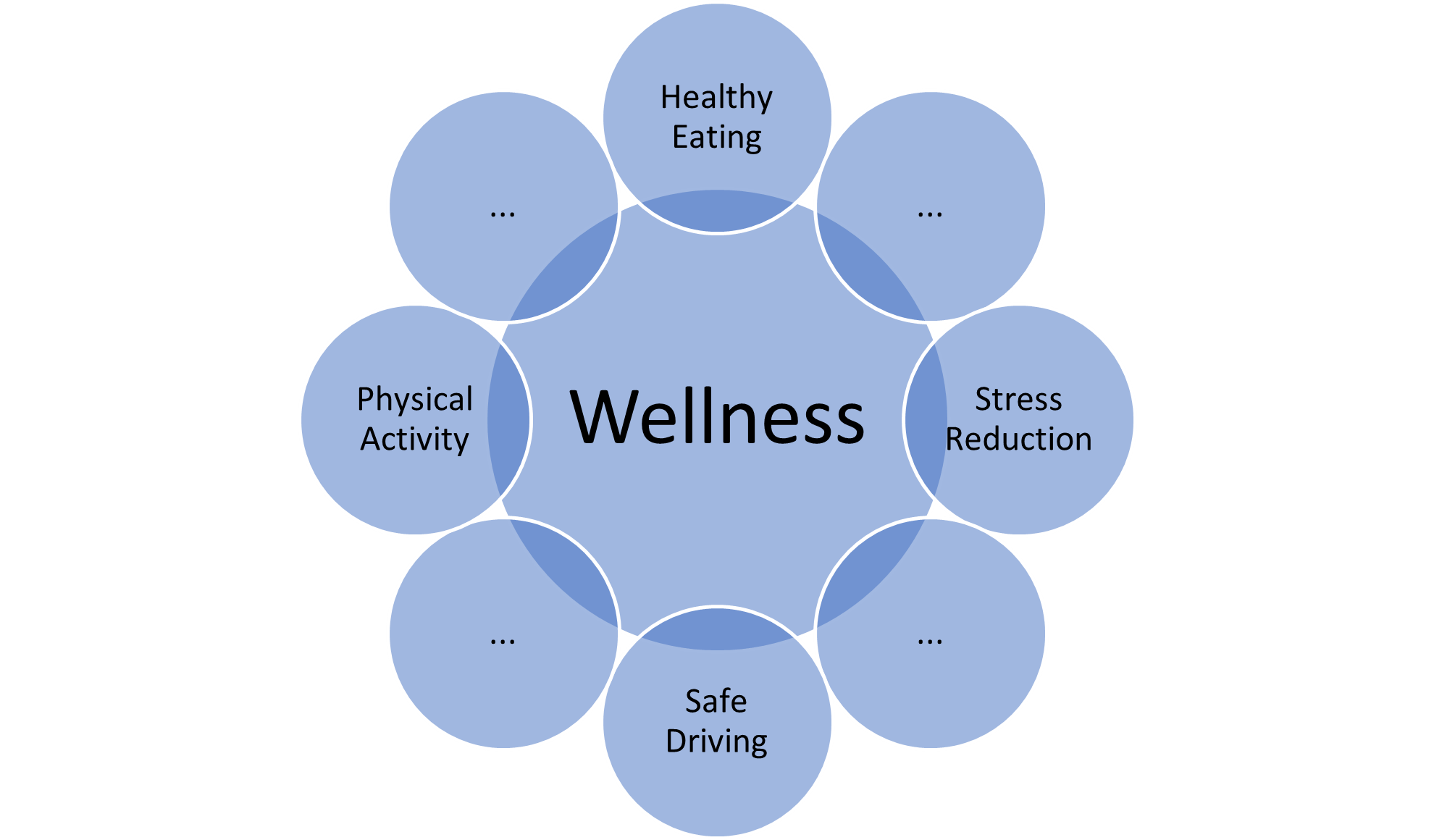
Wellness is a simple term that can have a variety of meanings to individuals, some of who have many preconceived notions and expectations about it. On a personal level, what it means and how it is framed can vary widely, as it is unique to one’s personal health journey. Health is complex—not just the act of being healthy, but the level of skepticism needed to guard something as precious as health. People can be skeptical of the latest fitness craze, the newest diet ideas or support in general for their health. Who can be trusted? This is not a rhetorical question. I believe one should ponder this question as we delve into a discussion of wellness and insurance.
Purpose of Wellness
Let’s take a step back from wellness for a moment and consider its purpose and intent: supporting individuals to achieve healthy outcomes. Health can have specific outcomes, such as smoking cessation or at-home care for continued independence. It can also mean reminders to drink water to stay hydrated or brush your teeth (an underwriter can explain, as I was once told, the high value of dental care and its impact on heart disease). This “why” behind wellness is the cause for consideration and the goal of improving outcomes.
When one considers the context of a goal of improving outcomes, insurance might not be the natural connection point. Most often, we think of insurance as what we use to protect against the bad things that could happen—improving outcomes is akin to a hedge on the insurance, the “insurance” to not need the insurance.
Simple examples of improving outcomes and insurance can highlight the point. Early in my career, I worked at a small Farm Mutual P&C insurer, where I witnessed a practical example. The insurer provided farmers with reflective tape to put on their farm machinery with the goal of reducing accidents with farm machinery. The reflective tape was a hedge. Hopefully, the farmer would be less likely to use the insurance purchased. Today, many home insurers provide access to water monitoring devices and discounts if the home has monitored security or fire detection. Insurers will also work with fleet drivers to develop routes with a risk of fewer accidents. These are examples of wellness. Although they sometimes do not directly affect a human, they are all very much intended to improve the outcome and often have human benefits.

Integrating Wellness in Life Insurance
Wellness in life insurance is not always simple, just as a direct impact on the health of an insured life. It is also not a new concept; many examples demonstrate that it has been a part of life insurance for decades. For example, some life insurance products have included a second opinion medical service for decades, intending to support insureds in seeking proper medical care. However, today we are seeing a new era of wellness integration with life insurance, evolving the conversation from why wellness and insurance are naturally paired to how much and what suitable wellness offerings to include with life insurance.
I’ve worked in the life insurance industry for more than 20 years and in the area of integration of wellness with life insurance for the past eight years. A week doesn’t go by where I am not pressed for details on the measurement and results of return on investment (ROI) on wellness. Like other business investments, the answer is simple—you get what you pay for. A focused and simultaneously broad investment will typically yield the best long-term results. A focused approach will usually deliver higher ROI on a narrow population segment, creating a high impact, lower frequency outcome on the population. At the same time, a broader solution will have a higher frequency of use, often offset by the lower value of the solution to create a low-impact high frequency. The key is to develop nurtured pathways to funnel the population into suitable wellness offerings that typically become enriched as the opportunity to impact the outcome becomes more available. Understanding your customers and their current and potential future health states is key to developing wellness solutions that will impact health outcomes.
Often I have seen insurers start with an inward methodology focused on solving the perceived needs of a few of their customers, picking a single outcome-based solution. This method is done without knowing how many of their customers would like this support, how prevalent an issue is in the target customer population, and without a well-thought-out plan for how to pivot with the least disruptive impact on the customer experience. Leading with an inward approach is not the experience users are typically familiar with. When Netflix, Amazon and Uber Eats make a recommendation, they use actual customer data to make those recommendations relevant and meaningful, and they collect feedback to make future suggestions better. This is the expectation of consumers today, and life insurers need to appreciate this and build similar customer journeys. The first investment that should be made in a wellness program is to listen and learn from your customers. Let your customers guide you to the opportunity for the greatest return on future investments.
At the core of a wellness strategy is the ability to excite customers to engage and persist with the offered solutions. To drive this engagement, several behavioral economic programs are employed to nudge, reward, leverage social bonds and use other techniques to support the customer in reaching a common goal of improved outcomes. However, it should be remembered that these behavioral economic programs are not the outcome or focus of a wellness program; they are there to enable the program. One key aspect of a wellness strategy is enabling the customer to have control. Health is a very personal and sensitive topic for a customer. Therefore, it’s imperative that they feel they have control over the process. This ability to provide control works in tandem to support a new type of risk assessment for acquiring life insurance and, more importantly, having control over life insurance costs.
Rise in Importance of Lifestyle Data
Life insurers, supported by reinsurers, are transforming their underwriting and pricing to include customer lifestyle data, which is most often gathered through a wellness program. Lifestyle data gathering is linked to wellness through the simple “something for something” economy. The something for something economy can be explained as follows. If you were asked early in the 21st century if you would allow a company to track your location (down to within a few meters) at all times, you most likely would have said, “No way.” However, most will say “yes” when presented with what we gain versus give up. For example, through map programs on our mobile devices, we share our location and gain instant awareness of where we are, how to get somewhere efficiently and the ability to search for the services at our fingertips.
For life insurers to succeed in gathering lifestyle data, they need this same value trade-off for the user. Life insurers that are getting this correct are winning in the marketplace because they are more likely to gain customers who feel they earn more than lose, where the gain is often positive reinforcement for positive lifestyle choices. Those customers who choose to share are interested in support for healthy living or reinforcement for their already healthy lives. Insurers not offering this value to customers in exchange for gathering lifestyle data must understand that, like it or not, this situation is occurring in the marketplace. They should consider the impact on their business by not attracting lives interested in maintaining and improving their health into their risk pools. There is a historical context to this situation: When smoker and nonsmoker rates were first introduced and life insurers gathered more data, those that didn’t distinguish rates by smoking status were put into an adverse scenario of getting more smokers priced at a blended smoker and nonsmoker rate.
In addition to the need to avoid the adverse selection outlined above, lifestyle data has risen in importance due to its increasing impact on mortality. The good news is that the 20th century enabled longevity to expand at its fastest rate in history, with the advent of sanitation systems, modern medicine and reductions in crime and accidents, thus leading to lifestyle factors rising in importance. In our modern world, mortality is heavily influenced by inactivity, poor nutrition, self-indulgences (alcohol, tobacco usage, etc.), and mental health issues (i.e., stress, etc.). This represents the challenge and opportunity of the 21st century—to continue to expand longevity by focusing on these lifestyle factors. Broad and focused wellness programs are making a difference already. In many ways, the life insurance industry is just beginning this journey with an opportunity to play a pivotal role. Life insurers can genuinely partner with their customers for life, with significant gains to be shared between customers (i.e., living longer, healthier and happy lives) and the life insurer (reduced costs of claims per dollar of premium).
Conclusion
Wellness means many things to many people, which is good. However, the critical next step for life insurers is to embrace this diversity and evolve from a repair-and-replace mandate to a true partnership with their customers that compliments the core function of insurance with a predict-and-prevent strategy. Wellness programs power the prediction by gathering lifestyle data through a something for something economy and, more importantly, enable prevention. This opportunity to positively influence the risks of a life insurer is why I am passionate about bringing wellness to life insurance, diving into this challenge headfirst.
Statements of fact and opinions expressed herein are those of the individual authors and are not necessarily those of the Society of Actuaries or the respective authors’ employers.
